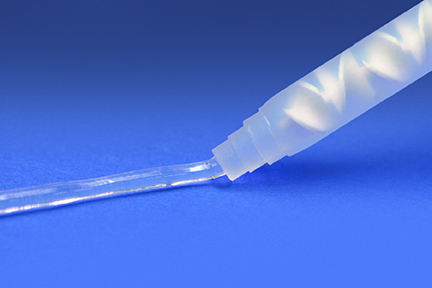Optimize Production With the Proper Silicone Adhesive Selection

Medical device manufacturers regularly use silicone adhesive solutions due to silicone’s biocompatibility and versatility. Determining your specific adhesive requirements early in the device development phase can save time later by avoiding unanticipated adhesion problems that can sidetrack the final manufacturing process.
Common Silicone Adhesive Options
Before choosing an adhesive that’s right for your manufacturing process, it’s helpful to first understand some of the available options. Most silicone adhesives are well-suited for creating a seal or bonding silicone to other silicones, metals, glass and some plastics. They can also be customized to enhance physical properties or modify adhesion to meet specific end-application requirements.
Historically, one-part moisture-cure room temperature vulcanizing (RTV) adhesives are the most common silicone adhesives used in medical devices. They can be applied directly and do not require premixing or heat. Cure rates are influenced by humidity levels, cure temperature, the surface area exposed to air and the thickness of the adhesive applied. One-part RTV adhesives are easily dispensed with no mixing required, but you should account for slower cure rates and some shrinking during cure.
Two-part RTV adhesives are among the most versatile silicone polymer compounds and cure much faster than one-part RTV adhesives. The curing process is initiated by mixing two components together and is not dependent on atmospheric moisture. These adhesives can meet unique assembly requirements, such as forming bonds at interfaces that have little or no access to air. Two-part RTV adhesives are also ideal for temperature-sensitive components and assembly processes where a relatively low temperature must be maintained. They adhere well to a variety of substrates and can also be used for sealing, potting or encapsulating. Typical work times range from 15 minutes to two hours depending on temperature, and shrinkage is minimal.
Similar to two-part RTV adhesives, high temperature vulcanizing (HTV) silicone adhesives are formulated to cure rapidly by applying heat. These two-part formulations have work times ranging from 15 minutes to greater than 24 hours. HTV adhesives are ideal when a quick cure is desired to save time in device assembly, and for bonding parts that are not heat-sensitive.
Substrates, Surface Prep and Inhibition
Besides selecting the optimal adhesive, the correct preparation of the substrate surface is essential to forming a long-lasting bond. Preparation methods must be appropriate to the surface finish, since that can influence surface contact and adhesion. Surface cleaning is the most important part. Cleaning, activating and/or priming the surface can maximize the surface area’s available bond sites and wettability to improve long-term adhesion.
When working with silicone adhesives, be sure to also consider any solvents, chemicals or substrates that your adhesives may contact in their uncured state. Certain chemical elements and compounds can inhibit curing during the device handling, storing or assembly process. This can lead to unacceptable variations in the finished product. Modest cure inhibition can result in lower physical properties, while severe cure inhibition can lead to a complete failure to cure. To determine whether substrate surfaces have been properly prepared, we recommend testing a small amount of silicone on the surface as a trial to evaluate potential inhibition effects.
Don’t Overlook Other Important Considerations
Many different physical, mechanical and chemical forces act against a bond. Determining an acceptable bond failure point will differ depending on the device, manufacturer and application, so it’s important to work with an adhesives supplier that can perform real-world tests to qualify adhesion, such as lap shear, peel strength and peel strength of cured bilayers from silicone dispersions.
In addition, medical-grade silicones should be biocompatible and conform with applicable ISO and USP testing protocols. During your selection process, be sure to consider high-purity, medical-grade silicone adhesives with extensive regulatory support and master files submitted to the FDA and international authorities. Master file (MAF) and good manufacturing practices (GMP) information on silicone adhesives help support medical device manufacturers in their regulatory filings with details about ingredients, manufacturing, processing, packaging and storage. This can be a time-saver in the long run when taking a device to market.
Finally, make sure your medical-grade silicones are designed and manufactured to strict purity standards, with carefully selected raw materials and established purification technology to produce the most refined intermediates and purest finished products with low volatility levels.
Collaboration for Best Results
With all the possible variations in adhesive formulations and application demands, it’s helpful to collaborate with a silicone adhesive manufacturer that offers access to a team of experienced chemists, engineers, technical specialists and even regulatory experts. Silicone chemistries can be customized to accommodate adhesion, substrate compatibility, performance characteristics and cure profiles. Depending on your application, look for a manufacturer with a wide range of customization and product development services, along with advanced manufacturing processes and equipment to meet specific adhesive requirements in both small batches and large batches at mass scale. In addition, your silicone adhesives manufacturer should have the ability to develop or adopt testing methods to help characterize your exact application needs and confirm that the silicone adhesive meets specifications. Essentially, early collaboration is the best way to plan for tight design and production parameters, while addressing any potential pitfalls that can hamper your medical device manufacturing process in the long run.